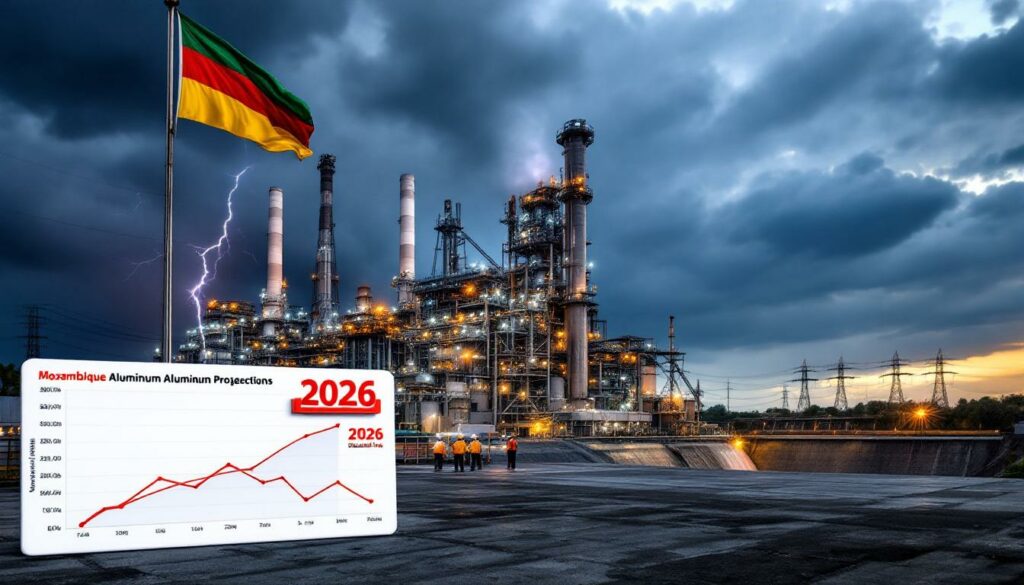The Mozal Aluminium Smelter Crisis: Understanding the Context
South32's Mozal aluminium smelter in Mozambique faces a significant operational challenge as electricity supply uncertainty looms beyond March 2026. This crisis threatens one of the company's key assets and has already triggered financial repercussions across its operations.
The company recently warned investors about an impending impairment expense in its FY25 financial results, reflecting the reduced confidence in Mozal's future operational viability. With formal recognition due by June 2025, analysts are closely monitoring the potential scale of this write-down.
Production planning has also been thrown into disarray, with South32 placing its FY26 output guidance "under review" as of July 2025. This uncertainty reflects the fundamental challenge aluminum smelters face without guaranteed power—continuous operation is non-negotiable in this energy-intensive industry.
"We are assessing the carry value of Mozal given the increased uncertainty regarding future electricity supply." — South32 corporate announcement, July 2025
The market has responded swiftly to these developments, with South32's share price dropping 3.7% to A$2.99 following the announcement on July 14, 2025. Despite this downturn, the company maintains a market capitalization of approximately A$14 billion, indicating continued investor confidence in its broader portfolio.
Technical analysis reveals the scale of Mozal's energy dependence—the smelter consumes between 900-950 MW annually, making it one of Mozambique's largest electricity consumers. This power requirement isn't merely a cost issue; it's existential for smelting operations that require uninterrupted supply.
What makes this particularly concerning is the precedent set during previous tariff disputes. During the 2020 HCB agreement collapse, Mozal was forced to reduce output by approximately 15%, illustrating how quickly electricity challenges can impact production volumes.
For Mozambique, the stakes extend beyond South32's balance sheet. The smelter contributes an estimated 7-9% to the country's GDP according to IMF estimates, making its continued operation a matter of national economic importance.
What's Causing Mozal's Electricity Supply Uncertainty?
The Expiring Power Agreement
At the heart of Mozal's challenge lies its expiring power agreement with Hidroeléctrica de Cahora Bassa (HCB), Mozambique's primary hydroelectric power generator. This contract, active since 2020, is set to expire in March 2026, creating a critical deadline for South32's operations.
Despite negotiations ongoing since 2023, the parties remain at an impasse. South32 has been explicit about the core issue: they've been "unable to agree an affordable price tariff despite years of discussions." This pricing dispute reflects the complex reality of power economics in a region with limited alternatives.
The situation is further complicated by Eskom's historical involvement. The South African utility has managed HCB operations since the 1920s, creating a unique cross-border power management arrangement that adds another layer of complexity to negotiations.
HCB's installed capacity of 2,075 MW should theoretically be sufficient for Mozal's needs, but recent performance tells a different story. Drought conditions have reduced output to approximately 1,500 MW in 2024, creating supply constraints across all HCB customers.
A troubling precedent emerged in 2022 when Eskom's $300 million upgrade investment in Cahora Bassa failed to prevent the 2024 drought shortfalls, raising questions about the long-term reliability of this power source regardless of contractual arrangements.
Environmental and Regional Factors
Environmental challenges are exacerbating the contractual impasse. Southern Africa has experienced rainfall levels 40% below the 10-year average from January to June 2025, according to the Famine Early Warning Systems Network (FEWS).
This severe drought has directly impacted electricity generation capacity at HCB, with the Cahora Bassa reservoir operating at just 32% capacity compared to its 65% five-year average as of June 2025. These reservoir levels translate directly to generation capabilities.
"Drought conditions in Mozambique have impacted electricity generation capacity," notes Isaac McIntyre of The Market Online, highlighting how climate factors are undermining energy security across the region.
HCB's reliability metrics further illustrate the problem—the utility has missed supply quotas in four of the past six quarters, according to their Quarterly Compliance Reports. This spotty performance casts doubt on whether any agreement, regardless of price, could guarantee Mozal's power needs.
The regional context offers little comfort. Similar drought conditions in Zambia led to a 30% output reduction at smelters dependent on the Kariba Dam in 2024. This regional pattern suggests South32's challenges aren't isolated but part of a broader climate-driven energy export challenges affecting Southern African industrial operations.
What Are the Financial Implications for South32?
Immediate Financial Impact
South32 and higher Mozal costs have created significant short-term financial consequences. The company has already announced an impending impairment expense in its FY25 financial results, reflecting the reduced confidence in Mozal's long-term viability.
Based on Mozal's approximately 15% asset weighting within South32's portfolio, UBS Metals Research estimates the potential impairment scale at A$500-700 million. This substantial write-down would materially impact the company's annual results.
Investor reaction has been swift and negative. Trading volume spiked 220% on the day of the announcement, with the share price dropping 3.7% to A$2.99. This reaction demonstrates the market's concern about both the immediate financial hit and longer-term implications for South32's production profile.
According to Australian accounting standards (AASB 136), companies must recognize impairments when an asset's viability faces "material risk." South32's announcement suggests they've crossed this threshold of uncertainty regarding Mozal's future.
"Impairment expense [will reflect] increased uncertainty regarding future electricity supply." — South32 corporate disclosure, July 2025
This situation mirrors similar challenges faced by other aluminum producers. When Alcoa lost its power contract for the Warrick smelter in 2021, it triggered a US$260 million write-off, providing a troubling precedent for what South32 might face.
Long-term Strategic Considerations
Beyond the immediate accounting implications, South32 faces profound strategic questions about Mozal's place in its portfolio. The smelter's 360,000-tonne annual output contributes approximately 11% to South32's aluminum volumes, making it a significant production asset.
More concerning is the regional dependency issue—approximately 68% of South32's African assets rely on Mozal infrastructure, according to Macquarie Research. This interdependence means electricity challenges could have cascading effects across multiple operations.
Energy costs represent about 35% of Mozal's operating expenses, making power pricing the single most important factor in the smelter's profitability equation. Even modest tariff increases could render the operation uneconomic in a commodity market with thin margins.
Industry precedent suggests drastic measures may be necessary if affordable power can't be secured. Russian aluminum giant Rusal demonstrated the lengths companies will go when it shifted smelting capacity from Siberia to hydropower-rich Tajikistan in 2023, prioritizing energy security over established infrastructure.
For South32 investors, this uncertainty raises concerns about the company's growth trajectory. If Mozal becomes unviable, the company would need to reallocate resources to replace this production, potentially requiring significant capital expenditure in other regions.
What Solutions Is South32 Pursuing?
Stakeholder Engagement Strategy
South32 has implemented a multi-pronged stakeholder engagement approach to address Mozal's electricity challenges. The company is currently engaged in tripartite negotiations involving the Government of Mozambique, HCB, and Eskom to secure a viable long-term solution.
These discussions have been ongoing since Q1 2024, reflecting the complexity and high stakes involved. South32 has emphasized that securing "affordable electricity supply" remains their primary objective, recognizing that merely securing power at any price would not maintain Mozal's competitiveness.
"Continuing to engage… on securing affordable electricity supply," South32 stated in their corporate disclosure, highlighting their focus on both availability and economic viability of power.
Eskom's historical role as the technical operator of HCB's grid since the colonial era adds another layer of complexity. This arrangement, detailed in "Eskom: A Century of Power" (University of Pretoria Press, 2020), means that any solution requires coordination across national boundaries and between multiple utilities.
Mozambique has previously demonstrated willingness to broker power agreements for industrial users. The government's 2022 Temane gas-to-power deal provides a precedent for state intervention to secure industrial energy supply, potentially offering a model for Mozal.
Alternative Approaches to Consider
Beyond negotiations with existing suppliers, South32 has several alternative approaches available to address Mozal's electricity challenges. Mozambique's renewable energy solutions potential offers promising options, with solar and wind capacity factors exceeding 50% according to IRENA's "Mozambique Renewables Readiness" report (2024).
Hybrid power solutions could provide partial independence from the grid. Technical analysis from GIZ's "Mozambique Industrial Decarbonization" study (2023) suggests that solar-diesel hybrids could provide 20-30% of baseload requirements, reducing dependency on HCB during peak pricing periods.
The aluminum industry already has successful models of self-generation. Emirates Global Aluminium's UAE smelter operates a 60 MW solar plant that reduces grid dependency by 18%, demonstrating the viability of renewable supplementation for energy-intensive operations.
HCB's 150 MW of idle gas peaker plants presents another potential stopgap solution. These facilities, originally built for grid stabilization, could be repurposed to provide backup capacity during hydropower shortfalls, creating a more resilient supply arrangement.
Energy efficiency improvements also offer incremental benefits. Modern point feeder technology allows smelters to operate at lower amperage during shortages without triggering the catastrophic "freeze" that occurs when pots cool completely, potentially enabling Mozal to weather intermittent supply disruptions.
How Does This Compare to Industry Power Challenges?
Aluminium Industry Energy Dependencies
Mozal's electricity challenges reflect aluminum smelting's fundamental vulnerability to energy supply disruptions. The industry's global energy intensity averages 14-16 MWh per tonne of aluminum produced, according to the International Aluminium Institute's "Aluminium Sector Energy Outlook" (2025).
This intensive energy requirement translates directly to cost exposure. Wood Mackenzie's "Aluminium Cost Curves" (2024) indicates that energy typically represents 30-40% of smelting operating expenses globally, making power pricing the primary determinant of competitiveness.
"Hydropower volatility is the primary risk for 47% of African smelters." — International Aluminium Institute, 2024 Risk Survey
The aluminum industry has developed various technological adaptations to manage power uncertainty. Point feeders developed in the last decade allow for lower amperage operation during shortages, providing flexibility previously unavailable to smelter operators. These advances, detailed in TMS Light Metals Conference Proceedings (2023), have extended the range of operational responses to power constraints.
Industry precedent shows how quickly power challenges can trigger production cuts. Hydro's Kurri Kurri smelter in Australia faced an 18-month shutdown in 2022 when power costs made operations uneconomic, despite the facility's technical viability. This precedent illustrates the binary nature of smelter economics—when power costs cross certain thresholds, continued operation becomes untenable regardless of other factors.
South32's Mozal facility faces particular challenges when compared to global peers. While the industry average energy intensity is 14-16 MWh/tonne, Mozal operates at approximately 14.8 MWh/tonne—slightly better than average but still highly vulnerable to power pricing volatility.
Regional Energy Market Dynamics
Mozambique's power infrastructure constrains South32's options. The country has 4.3 GW of installed capacity, but only 3.1 GW is consistently reliable according to EDM (Electricidade de Moçambique). This limited domestic capacity increases dependence on specific generators like HCB.
The broader Southern African Power Pool (SAPP) offered less than 500 MW of surplus capacity in 2024, limiting the potential for cross-border solutions. This regional tightness means that even with transmission interconnections, securing alternative supply sources remains challenging.
"Industrial power security is our economic priority," Mozambique President Filipe Nyusi stated in June 2025, acknowledging the national importance of resolving challenges facing major electricity consumers like Mozal.
The technical realities of regional power sharing further complicate the picture. HCB's export lines to South Africa and Zimbabwe have 1,420 MW of transmission capacity, creating competition for Mozambique's hydropower resources across multiple countries and major industrial users.
Recent regional precedents demonstrate creative approaches to similar challenges. Zimbabwe's 2023 energy swap arrangement temporarily diverted HCB power to smelters during drought conditions, illustrating the potential for flexible regional arrangements to address shortfalls.
Mozambique's electrification trends offer long-term hope. Projects like the Mphanda Nkuwa hydroelectric facility could add 1,500 MW of capacity to the national grid, though completion timelines extend well beyond Mozal's immediate 2026 deadline for securing new power arrangements.
What Should Investors Watch For?
Key Indicators and Milestones
Investors should focus on several critical milestones as South32 navigates Mozal's electricity challenges. The most definitive deadline is March 31, 2026, when the current HCB contract expires, creating a firm timeline for resolution.
Before this ultimate deadline, South32's financial reporting will provide crucial insights. The FY25 results expected in August 2025 will quantify the impairment expense, providing clarity on management's assessment of Mozal's long-term value under current conditions.
The company's FY26 production guidance, typically released in Q1 2026, will signal management's confidence in resolving the electricity situation. Any significant reduction in projected output would suggest limited progress in securing affordable power.
From an accounting perspective, the impairment will likely be classified as "non-recurring" in South32's income statement, following standard practice for asset write-downs as outlined in KPMG's "Mining Sector Impairment Guide" (2024). This treatment will help investors distinguish between ongoing operational challenges and one-time accounting adjustments.
South32's handling of previous impairments provides context for what to expect. The company's 2023 SAEC impairment resulted in a $1.3 billion charge following a comprehensive coal asset review, demonstrating management's willingness to take significant write-downs when asset conditions deteriorate.
Broader Investment Considerations
Beyond Mozal-specific developments, investors should consider how aluminum market dynamics affect South32's broader outlook. According to Citi Commodities Research (July 2025), a 10% drop in aluminum prices erodes Mozal margins by approximately $50/tonne, illustrating the dual vulnerability to both energy costs and commodity prices.
Environmental, Social, and Governance (ESG) considerations add another dimension to the analysis. Mozal's hydropower dependency currently yields 75% lower Scope 2 emissions than coal-dependent peers, according to South32's Sustainability Report (2024). This favorable carbon position could be compromised if alternative energy sources involve higher-emission fuels.
Regional energy transition dynamics will influence long-term power availability. Eskom's planned retirement of 8.1 GW of coal fleet capacity by 2030 may further tighten the regional electricity market, potentially making future power contracts even more challenging to secure at competitive rates.
Industry parallels offer cautionary tales. Vedanta's Zambian smelters faced operational curtailment following ZESCO tariff hikes in early 2025, demonstrating how quickly pricing changes can impact production decisions in the aluminum sector.
For South32 investors, Mozal's challenges highlight the importance of portfolio diversification. While the immediate financial impact of potential curtailment or closure would be material—with Jefferies models suggesting a 3-5% EPS impact—the company's broader portfolio provides some insulation against site-specific challenges. Moreover, following industry evolution trends will be crucial for understanding South32's strategic response to these challenges.
FAQ: South32's Mozal Electricity Challenges
What is the Mozal aluminium smelter?
Mozal is South32's aluminium smelting operation in Mozambique that produces approximately 360,000 tonnes annually. The facility makes a significant contribution to Mozambique's economy—representing 7-9% of GDP according to IMF estimates—but faces uncertainty regarding its electricity supply beyond March 2026 when its current power contract expires.
Why is electricity supply critical for aluminium production?
Aluminium smelting is among the most energy-intensive industrial processes, requiring 14-16 MWh per tonne of production. This continuous power requirement cannot be interrupted without causing catastrophic "freezing" of the molten aluminum, potentially destroying equipment
Ready to Spot the Next Major Mineral Discovery?
Discovery Alert's proprietary Discovery IQ model instantly notifies investors of significant ASX mineral discoveries, transforming complex data into actionable insights for both short-term traders and long-term investors. Explore our dedicated discoveries page to understand why major mineral discoveries can lead to extraordinary market returns, and begin your 30-day free trial today.




